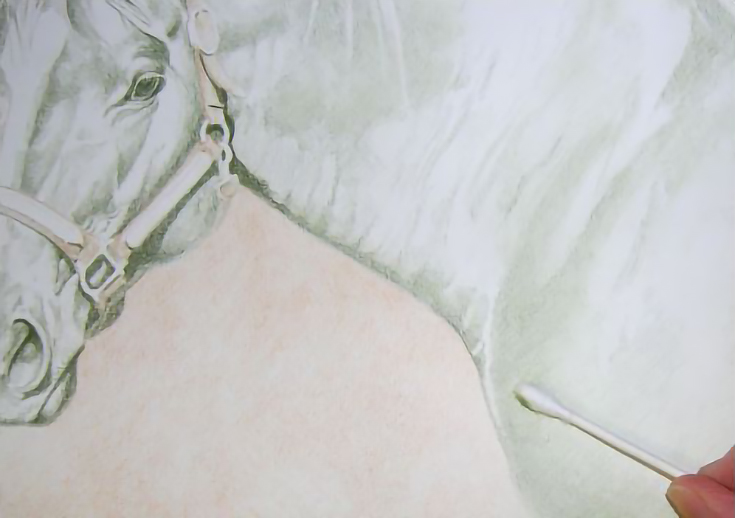One thing every colored pencil artist can agree on that colored pencils are a slow medium. There’s just no way around it. If your chosen medium is colored pencil, your work progresses stroke by stroke.
I’ve alluded to this in the past. From tips on making the most of every stroke to finishing what you start, I’ve talked all around the subject.
But what do you do when you find yourself bored to tears over a project that you originally started with enthusiasm and excitement? Is there any hope for getting it done when you’ve lost all interest?
I’ve been there many times, and I can tell you from personal experience that there is a way to motivate yourself to complete that now-uninspiring project. Here are a few of my favorite methods:
1. Make subtle changes to how you draw
Most of us fall into the habit of holding a pencil the same way; usually the same way we hold a pen or pencil for writing.
But is that the best way to hold a colored pencil when you’re drawing? Maybe your low level of interest is because your hands, wrists, and arms are subtly telling you they’re tired! If that’s the case, try holding the pencil differently.
If you usually hold a pencil down toward the tip, try holding it further up the barrel. Or if you usually hold it vertically, try angling it a little more with a horizontal grip.
It may seem like a simple or silly method, but I’ve found that changing grips not only allows me to make different types of marks on the paper; it gives my hands, wrists, and arms a bit of a break. Even a slight change in grip or pencil position can relieve the physical stress of drawing, and help you get past the doldrums of a drawing.
2. Try a different location!
This is one of my biggest problems with finishing pieces, especially more complex ones. I sit at the same desk, in the same chair, and work with the drawing at the same angle (usually flat on the desktop) until every part of me cries for change. Most of the time, that means putting the drawing aside and walking away.
But not always.
Sometimes, I take everything to my favorite easy chair, or to the couch in the front room, or even to a lawn chair on the front porch. Even if I work in those places for only twenty or thirty minutes, it’s often enough to give my body and mind a new perspective.
And trust me, a body and mind with a new perspective means that tedious piece no longer looks quite so tedious!
3. Focus on just ONE small section at a time
Sometimes it’s the scope of the work remaining that feels daunting. If that’s the case, try to focus in on your drawing section by section. Do as much as you can with each area, then move on to the next area. Some compositions are perfect for working this way.
The portrait I’ve shared below was ideal for that working method. Each piece of harness (and each part of the horse seen through and around the harness) could be drawn individually with ease. It was like putting a puzzle together, and it kept my brain interested in each different area.
But not all projects are designed that way. This next portrait had no natural divisions like the one above, and it was just as large. But you can still split up a portrait like this into small sections as well.
Just “mask” everything but the section you’d like to work on by covering it with plain paper. Work on the part of the drawing you can see, then move the mask to reveal another area. Easy!
If it helps, feel free to enlarge or zoom in closer on your reference photo to just show the same area.
4. Use blending tools to speed up your process
My current project isn’t going as quickly as I’d like (what project ever does?)
Just yesterday, I was very dissatisfied with how it looked and where I was at. I couldn’t set it aside without improving it, so I decided to try something other than what I’d planned. Rather than relying on multiple layers to blend colors, I used a cotton swab to blend some areas. It took less than ten minutes, and it made a world of difference to the project and how far along I felt I was.
Those attitude changes are even bigger benefits than just creating smoother color!
5. Brainstorm your own way to “draw differently!”
We all have reasons for feeling listless about a drawing. Maybe you can try changing up your intentions, and see if that helps. Or try different colors, or look at a few other artist’s work who you admire. The purpose isn’t to change the final outcome, of course—the goal is to inject a spirit of adventure into the process. If you can make an experiment out of it, you can spark renewed interest and the tedium disappears.
You may not always be as experimental with a portrait or other type of client work, but it’s a fantastic way to move forward on most other pieces. And who knows what new technique you might discover!
So go on, ttry one of my methods above, or come up with your own!
Once you do, I have no doubt you’ll quickly get past the drudgery—and the discouragement—of your current drawing, and bring it to a successful conclusion!
This post may contain affiliate links.



